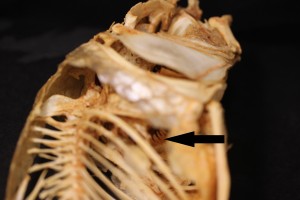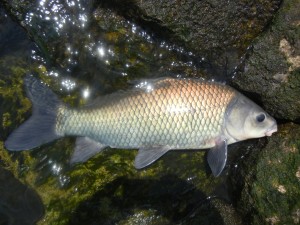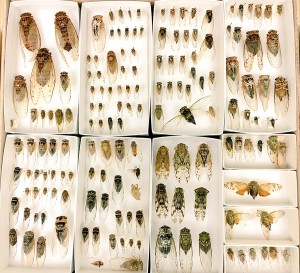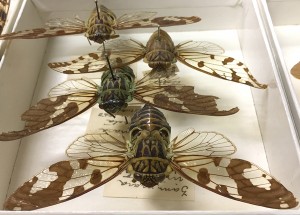
A frequent subject of our writings, the Bowfin
Only vertebrates have true teeth, and the type of teeth they have is indicative of the feeding niche they occupy. Fishes portray an amazing picture of diversity in teeth and correspondent feeding niches. Some fish species have no teeth at all and thus rely on their mouths to either crush their prey as in the sturgeon, or simply suck in their prey as in the seahorse and pipefish. Some have very few teeth, such as the non-parasitic lampreys in adult form, and some have an absolutely terrifying array of teeth such as the pikes and the sharks.
![IMG_1866[1]](https://u.osu.edu/biomuseum/files/2016/05/IMG_18661-2e0qnsx-300x200.jpg)
Ventral, exterior view of a Northern Pike jaw
The placement (marginal, medial and pharyngeal) of teeth within a fishes’ mouth is one of the many characters that are used to differentiate fish species. But a Northern Pike seems to have almost all the surfaces covered:

Disarticulated Northern Pike jaw. As you might imagine, once the prey fish is caught with the canine teeth and moved into the mouth there is little chance for escape.
Piscivorous fish typically have long, sharp teeth, but some piscivores rely on strategies alternative to their dentition to capture their prey. The billfishes (marlins, sailfishes and swordfishes) stab and stun their prey with their elongated rostrums, sawfishes slash with a many-toothed rostrum to “collect” their prey. Electric eels stun prey fishes, while toadfishes, anglerfishes and batfishes use a lure on their snouts or at the end of an extension to attract small fishes and may include a pheromonal attractant. Such species typically have numerous smaller rows of teeth to grasp and hold their victims.
Fishes also exhibit diversity in the attachment of the teeth in their jaws: The “Type I” arrangement has a strong mineralized connection between the tooth and and the jaw in bichirs, gars, bowfin, lower teleosts and some higher fishes (or the tooth and the pharyngeal bone in paddlefishes). The “Type II” arrangement is seen in many teleosts with mineralization incomplete and the tooth connected to the jaw by collagen. Stomiiformes (the order in which such bizarre, deep sea creatures as dragonfish, marine hatchetfish and viperfish are placed) have the Type III attachment with teeth hinged and depressible for moving prey to the esophagus and then erectible to prevent prey from escaping. The Type IV attachment has collagen at the posterior part of the tooth base and acts as the hinge with the anterior edge lifting off the base (exposing the pulp cavity) to trap prey, this arrangement is found in pikes, some stomiiforms and higher teleosts.
Some fish groups such as sharks, wrasses, filefishes and triggerfishes exhibit polyphyodontia, the lifelong replacement of teeth. A new tooth develops in the dental lamina under or behind the existing teeth. In the sharks, for example, only the front 1 or 2 rows are used for feeding, while teeth develop posteriorly and move anteriorly to replace teeth individually as needed and on a regular basis. In some shark species this occurs as frequently as every 9-12 days in the sandbar sharks or as infrequently as two to four times a year in the blue shark; with the old teeth drop to the ocean floor. Exceptions include some like the cookie cutter sharks where the entire upper and lower sets are replaced as units and swallowed. Piranhas replace one entire side of the teeth on their jaws at one time. Polyphyodontia is a character that is not unique to fish however; a few mammals (kangaroos, elephants and manatees) and several reptiles replace their teeth too. Many bony fish are monophydontic and develop only one set of teeth, while most mammals are diphydontic, replacing their teeth only once.
Below are several examples of fish groups or individual species that exemplify the variety in fish dentition and coincident feeding niches. Forthcoming at the end of the week I’ll post images of these species and their teeth.
Lampreys – start out their life cycle with a toothless mouth suited to filter feeding, and in the parasitic forms develop several circular rows of sharp teeth used for latching onto and rasping a hole in their prey.
Sharks– teeth are triangular and razor sharp, those on the lower jaw have small serrated lateral cusps at the bases for enhanced cutting and tearing that is facilitated with strong jaw musculature and shaking motion of the head or chewing. Sharks, unlike the higher fishes, do not have pharyngeal jaws associated with their gill baskets.
Lungfish – have a tooth structure unique among the vertebrates: sturdy tooth plates called “Odontodes” that are used for grasping and crushing prey
Gar – rows of small villiform teeth for capturing and holding fishes in their elongated jaws while they manipulate the fish to a headfirst position for swallowing
Bowfin – many sharp caniform, inward pointing teeth on the premaxilla, dentary and maxilla jaw bones for grasping and holding the prey (an extreme example of canine teeth is shown in the African Tigerfish)
Pike – the long, sharply curved caniform teeth on the dentary are a prelude to a villainous array of cardiform teeth on the premaxillary, basibranchials, last two pharygobranchials, vomer, palatines, and glossohyal bones.
Grass Carp – the heavy pharyngeal teeth of these herbivores are used for shredding algae
Piranha – teeth are triangular, razor sharp, with small lateral cusps at the bases like sharks
River Redhorse – feed on sand-dwelling mollusks with sturdy teeth on lower pharyngeal jaws (characteristic of all ostariophysans whereas higher teleosts have pharyngeal teeth on lower and upper arches like the redear sunfish) used for crushing molluscs found in the bottom substrates
Flathead Catfish – gulp prey with large, non-protrusible mouth and hold with cardiform teeth, the largest patches of which are on the premaxillary and anteior dentary bones
Largemouth Bass – have limited cardiform teeth on the medial jaw bones, but these are complimented by a large, protrusible mouth for engulfing prey
Ocean Pout – like many molluscivores have strong conical dentition on the anterior portion of their jaws for plucking mollusks from surfaces, and flattened, molariform teeth in marginal or pharyngeal jaws
Triggerfish (incisor-like dentition), Pufferfishes (teeth fused into parrotlike beak) – have powerful oral jaws to remove invertebrate prey (sponges, ascidians, coelenterates and chitons) from surfaces
About the Author: Marc Kibbey is Assistant Curator of the OSU Fish Division at the Museum of Biological Diversity.






























![IMG_1866[1]](https://u.osu.edu/biomuseum/files/2016/05/IMG_18661-2e0qnsx-300x200.jpg)
